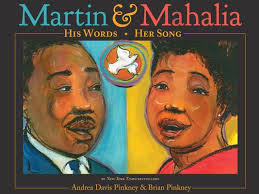
Brian Pinkney's art was some of the first I saw this year. Busy-Busy Little Chick chirped at me from the booth at ALA last summer, and I was smitten. While Little Chick might not be as sparkly and complicated as some of the other books we have talked about this year, it still is worthy of discussion. Janice Harrington has a way with words, and no doubt her jaunty language inspired Pinkney's gestural, movement-filled watercolors. The traditional tale, from the Nkundo people of Central Africa, is a bit of a reverse "Little Red Hen" story. Instead of building a sturdy house for her family, Mama Nsoso is distracted by tasty worms, crickets, and corn. Fortunately, her dedicated littlest baby chick ignores the food and collects leaves and twigs, grass and mud, and builds a warm house for the whole brood. The lesson is, I suppose, that if you want something done, you'd better do it yourself.
What I liked:
- strong black (watercolor? India ink?) outlines of Mama Nsoso and the chicks, especially when they are cuddling together
- action-filled gestural drawings
- white space when the Little Chick works by himself and when the family is out and about during the day
- the way Pinkney captures the busy-ness of Little Chick's feet when he is collecting mud
- nighttime scenes painted on paper saturated with the background colors
- the helpful author's note and glossary for those unfamiliar with the use of sounds ("cwa-cwa-cwa"; "tee-tee-tee") in this type of storytelling
What I am concerned about:
- the paper is not thick enough to handle the dark watercolors, and this distracts the eye. Even the text on the next page is easily seen through the paper
- most of the illustrations mirror rather than extend the text

And then, as we were putting our list together this fall, Sam Bloom brought Martin & Mahalia: His Words, Her Song (written by Andrea Davis Pinkney) to our attention. (This is what Sam said: "MARTIN AND MAHALIA wipes the floor with BUSY LITTLE CHICK.") I had not seen it and quickly made sure I did. This beautiful volume is sure to become a staple on the Martin Luther King Jr. shelves and will help introduce today's children to role of Mahalia Jackson in the civil rights movement.
What I liked:
- the use of color: rich blues and greens for King, deep reds and oranges for Jackson, purples and magenta when King and Jackson are on the page at the same time
- the path that begins before the title page, introducing the map and path motif that is a big part of the story
- the white dove that appears on just about every spread, flying across the pages, leading the reader to each page turn
- Bolded words in the main text reflect the words in many of the paintings
- India ink outlines of the foreground scenes juxtapose with the lightly painted background scenes
- circles everywhere (acting as halos?)
- six pages of backmatter, including bibliography, discography, timeline, and discussion of the art
- some of the handwritten words in the illustrations are hard to read, especially for the child reader who may be unfamiliar with cursive or stylized uppercase letters ("I've been 'Buked and I've Been Scorned" is hard to read and then explain to the youngest listener, especially when compared with the clarity of presentation of the spread featuring King's words "I Have a Dream")
- the two vertical spreads are jarring, taking the reader out of the rhythm of the story to turn the book ninety degrees and then back again
Add Comment :-
RELATED
ALREADY A SUBSCRIBER? LOG IN
We are currently offering this content for free. Sign up now to activate your personal profile, where you can save articles for future viewing.









